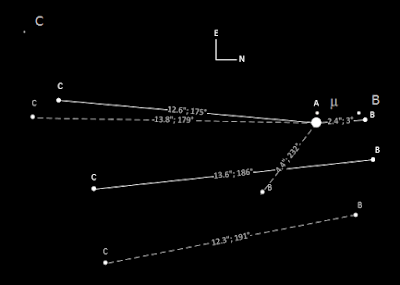Checked the info in the Washington Double Star database. The AB and AC data is very similar to the numbers I'm seeing in SkyTools 3 Professional. Both show the magnitude is around 13 to 14. Quite doable in many of the instruments that I have access to. The position angle and separation values, again, are very consistent. The dim C star should be south of the AB pair, opposite B, but well away, 4 or 5 times the distance of AB.
Viewed on 3 Aug 2009. That appears to be the first ever. But then, I was only going after the AB pair, from the Sky & Tel list. Probably did not even know there was a C then... (didn't have SkyTools that summer). Viewed on 31 May 2014, 6 Jul 2014, and on 17 Apr 2016. Never spotted the C.
The WDS has a very strange entry by Burnham for the BC pairing.
date: 1889 1958
theta (PA) °: 191 186
rho (sep.) ": 12.3 13.6
That makes no sense at all. I visually checked the numbers using Visio.
The dashed lines are the first observations (some of which are over 200 years old). The solid lines should be the current (or recent) positions and distances. The lower 2 lines are for the BC entry, that is, the PA and sep between B and C. Clearly the angle and separation are wrong/different. Finally, I loaded in the screen snapshot from SkyTools and pushed it to the background. The dots above the A and B labels along with the C near the top-left indicate how the ST3P software is plotting the star positions. Again, not too far off. I made no attempt to scale the snap to the diagram. Regardless, the PA for A and B looks spot-on.
[ed: Could it be that Burnham was looking at A and C?! The separation values are very consistent although the angles are different.]
[ed: Could it be that Burnham was looking at A and C?! The separation values are very consistent although the angles are different.]
I also the checked Aladin image and SIMBAD data. The AC pair angle looks very good. B looks like it is OK in terms of separation but the angle is different—B is more counter-clockwise than in the graphic above. Still, quite good correspondence. Sadly, the Aladin image is not useful visually as the A and B stars overwhelmed the sensor.
Wonder if I should image this area...
§
Done.
§
Tried again visually to spot C on the evening of 3 July with a big Dob... No joy.
Wonder if I should image this area...
§
Done.
§
Tried again visually to spot C on the evening of 3 July with a big Dob... No joy.



No comments:
Post a Comment